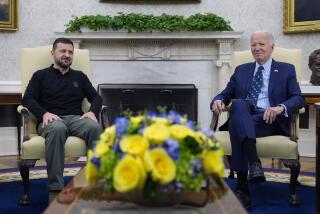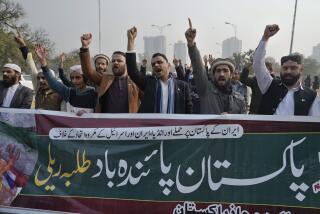Cables reveal U.S. misgivings about Pakistan
- Share via
Reporting from Islamabad, Pakistan — Months before the Obama administration this year urged Congress to provide $2 billion in military aid to Pakistan as part of an ongoing strategy to win over a reluctant ally in the war on terror, Washington’s top diplomat in Islamabad had flatly warned that a cash-for-cooperation approach would never work.
Ramped-up financial aid would not be enough incentive for Pakistan to sever ties with militant groups that attack U.S. and NATO troops in Afghanistan, then-Ambassador Anne Patterson said last year in recently disclosed diplomatic cables, because Islamabad views those groups as a hedge against the prospect of a pro-Indian government in Kabul.
“There is no chance that Pakistan will view enhanced assistance levels in any field as sufficient compensation for abandoning support to these groups, which it sees as an important part of its national security apparatus against India,” Patterson wrote in a Sept. 23, 2009, cable to Washington. “The only way to achieve a cessation of such support is to change the Pakistan government’s own perception of its security requirements.”
The diplomatic cables released by the WikiLeaks website this week show Patterson’s misgivings about Washington’s blueprint for defeating militancy in Afghanistan and along its volatile border with Pakistan. She strongly indicated that as long as Pakistan, particularly its military and intelligence commanders, view Indian involvement in Afghanistan as a threat, links with the Afghan Taliban and its allied Haqqani network would remain strong.
Islamabad is convinced, Patterson said, that a pro-Indian government in Kabul would give India the means to conduct a proxy war against Pakistan from Afghan territory.
“Money alone will not solve the problem of Al Qaeda or the Taliban operating in Pakistan,” wrote Patterson, who left Islamabad earlier this year. “A grand bargain that promises development or military assistance in exchange for severing ties will be insufficient to wean Pakistan from policies that reflect accurately its most deep-seated fears.”
The United States in the last nine years has provided more than $13 billion in military equipment to Islamabad, and pledged the additional $2 billion in October. In addition, the U.S. and other countries supplied hundreds of millions of dollars for flood relief efforts this year. Washington is also providing a $7.5-billion non-military aid package over five years.
But the cables have sketched out in vivid detail the deeply troubled relationship between the U.S. and Pakistan.
Pakistan’s mistrust of Washington’s intentions dates to the Soviet invasion of Afghanistan, when the U.S. teamed up with Pakistan to support Afghan mujahedin, then abandoned the region once the war was over. Since then, Pakistan has worried the United States will detach itself again once the Afghan Taliban have been defeated or rehabilitated into Afghan society.
The U.S., in turn, finds it hard to trust an ally that battles insurgents who strike within Pakistan, but doesn’t act against militants who launch attacks on coalition forces in Afghanistan.
The cables depict a Pakistan that confounds the U.S. by apparently actively supporting Afghan Taliban.
In the southern Pakistani province of Baluchistan, the government and military allow the Afghan Taliban’s leadership, known as the Quetta Shura, to operate “unfettered,” according to a cable describing a Nov. 25, 2008, briefing given to NATO officials by Peter Lavoy, U.S. national intelligence officer for South Asia. In the Pakistani tribal region of North Waziristan, Lavoy said, Pakistan’s Inter-Service Intelligence agency provides information and cash to the Haqqani network, regarded by the U.S. as one of the biggest threats to coalition forces in Afghanistan.
Lavoy said the way Pakistan sees it, ensuring the Afghan Taliban a prominent place in the post-U.S. Afghanistan landscape prevents India from building a powerful alliance with Kabul. Backing the Afghan Taliban, he said, also keeps those insurgents from redirecting their violence toward Pakistan.
“Urging militant groups to be outwardly focused,” the cable described Lavoy as saying, “is perceived by Pakistani officials as a method to safeguard internal security.”
Pakistan’s preoccupation with its nuclear archrival, India, is illustrated by its decision to ratchet up its nuclear arsenal while neglecting an economy in tatters. Despite a third of its population being either unemployed or underemployed and an economy crippled by severe energy and water shortages, “Pakistan is producing nuclear weapons at a faster rate than any other country in the world,” the cable quoted Lavoy as saying.
On some levels, however, Pakistan has exhibited measures of cooperation that the U.S. has found encouraging, the cables show.
The U.S. has relied heavily on drone missile strikes to target Taliban and Al Qaeda hide-outs in the Pakistani tribal areas of North and South Waziristan, a campaign that the Pakistani government has consistently condemned publicly as a violation of the country’s sovereignty. However, an Aug. 23, 2008, cable describing a meeting between Patterson and Prime Minister Yousuf Raza Gilani and Interior Minister Rehman Malik provides confirmation that Pakistan condones the drone campaign.
Patterson reported that when the discussion turned to the subject of drone strikes, Malik asked that they be postponed until after a Pakistani military operation. But Gilani said, “I don’t care if they do it as long as they get the right people. We’ll protest in the [parliament] and then ignore it.”
She summed up in a Feb. 21, 2009 cable to Washington, “the relationship is one of co-dependency we grudgingly admit — Pakistan knows the U.S. cannot afford to walk away; the U.S. knows Pakistan cannot survive without our support.”
More to Read
Sign up for Essential California
The most important California stories and recommendations in your inbox every morning.
You may occasionally receive promotional content from the Los Angeles Times.










